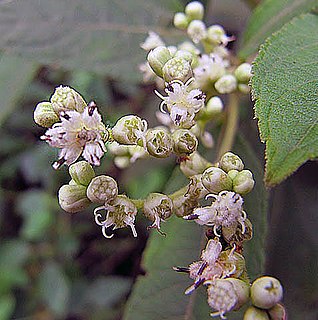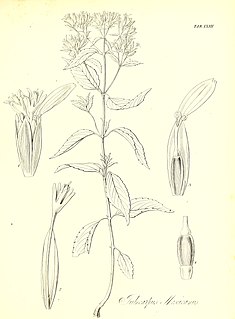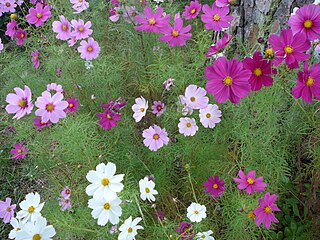Harold Ernest Robinson was an American botanist and an entomologist.

The Heliantheae are the third-largest tribe in the sunflower family (Asteraceae). With some 190 genera and nearly 2500 recognized species, only the tribes Senecioneae and Astereae are larger. The name is derived from the genus Helianthus, which is Greek for sun flower. Most genera and species are found in North America and South America. A few genera are pantropical.

Clibadium is a genus of flowering plants in the family Asteraceae.
Pappobolus is a genus of flowering plant in the sunflower family native to the Andes Mountains of Colombia, Ecuador, and Peru.

Asteroideae is a subfamily of the plant family Asteraceae. It contains about 70% of the species of the family. It consists of several tribes, including Astereae, Calenduleae, Eupatorieae, Gnaphalieae, Heliantheae, Senecioneae and Tageteae. Asteroideae contains plants found all over the world, many of which are shrubby. There are about 1,135 genera and 17,200 species within this subfamily; the largest genera by number of species are Helichrysum (500–600) and Artemisia (550).

Calea is a genus of flowering plants in the aster family, Asteraceae. They are distributed in tropical and subtropical regions in Mexico, Central America, and South America.

Guardiola is a genus of plants in the family Asteraceae, native to Mexico and the southwestern United States. Members of the genus are subshrubs with simple, opposite leaves and terminal inflorescences.

Coreopsideae is a tribe of flowering plants belonging to the Asteroideae subfamily. It includes widely cultivated genera such as Cosmos and Dahlia.

Amblyolepis is a genus of flowering plants in the daisy family described as a genus in 1836.
Damnxanthodium is a monotypic genus of flowering plants in the family Asteraceae, containing the single species Damnxanthodium calvum. It is native to northern Mexico.

Iostephane is a genus of Mexican flowering plants in the sunflower family.
Steiractinia is a genus of South American plants in the tribe Heliantheae within the family Asteraceae.
Rensonia is a genus of Mesoamerican plants in the tribe Heliantheae within the family Asteraceae.
Rhysolepis is a genus of Mexican plants in the sunflower tribe within the daisy family.

Perymenium is a genus of South American and Mesoamerican plants in the tribe Heliantheae within the family Asteraceae.
Heliopsis lanceolata is a rare South American species of flowering plant in the family Asteraceae. It has been found only in Colombia. It, H. canescens, and H. decumbens are the only three known species of their genus endemic to South America. All the other species are indigenous to North America, with one (H. buphthalmoides) found on both continents.
Heliopsis decumbens is a rare South American species of flowering plant in the family Asteraceae. It has been found only in Peru. It, H. canescens, and H. lanceolata are the only three known species of their genus endemic to South America. All the other species are indigenous to North America, with one (H. buphthalmoides) found on both continents.
Heliopsis buphthalmoides is a New World species of flowering plant in the family Asteraceae. It is the only member of its genus native to both North America and South America. It is found in Mexico, all 7 countries of Central America, and western South America.
Heliopsis parviceps is a Mexican species of flowering plant in the family Asteraceae. It is native western Mexico in the states of Sinaloa, Michoacán, Guerrero, and México.
Hymenoxys ambigens is a species of flowering plant in the daisy family known by the common name Pinaleño Mountains rubberweed. It is native to the states of Arizona and New Mexico in the southwestern United States.








